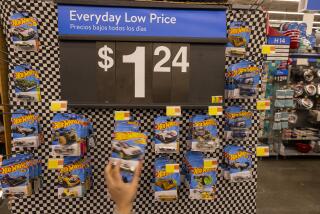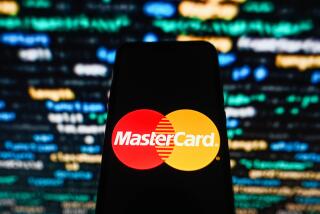Stores Find It Expensive to Make Public Guess at Prices
- Share via
WHITE PLAINS, N.Y. — Sometimes, it seems that price tags have gone the way of high-fat foods and dainty, white gloves.
Replaced by high-tech bar codes and shelf labels that often are missing, shoppers have become increasingly frustrated at not being able to find the price of what they want to buy.
So some communities are fighting back by strictly enforcing laws that require retailers to label every item with a price tag.
“We don’t expect stores to label every nut and bolt,” said Castrenze DiCarlo, director of consumer protection in New York’s Westchester County, one area with an item-pricing law. “But they need to know that consumers have the right to know how much they are paying before they get to the register.”
Years ago, everything had a price tag. From hosiery to hair spray, stores labeled all merchandise, whether it cost 99 cents or $199.
But the need for price tags faded as retailers turned to high-tech systems, which require less labor and process purchases more quickly.
The first electronic scanner was installed in 1974 in Troy, Ohio, and now nearly every item bears a Universal Price Code (UPC), a series of numbers and vertical bars that represent price and other product information.
“It just became more practical for retailers to use bar codes or other systems,” said Bruce Van Kleeck, vice president of the National Retail Federation, a Washington-based trade group. “It took away problems that came with human error.”
As retailers phased out price tags, consumers began to complain that out-of-order shelf labels made it difficult to locate prices and electronic scanners misread UPCs.
A Federal Trade Commission study last year of 17,000 items at 294 stores found 4.82% of all purchases scanned incorrectly, regardless of whether the consumer was overcharged or undercharged.
“You pick up a product, you want to know if you have enough money to buy it,” said Adam Green as he shopped at The Westchester, an upscale mall in White Plains, N.Y. “You don’t want to wait until you reach the checkout counter.”
*
To deal with such complaints, some state and local governments have passed laws requiring stores to price nearly every item or face substantial penalties. In Westchester County, fines can run retailers $100 for every item not labeled.
Michigan has one of the nation’s toughest pricing laws. Enacted in 1976, retailers must put a price sticker on nearly every item sold in a retail outlet or face fines of up to $25,000.
Inspectors around the state report violations, as do consumers who have learned about the pricing regulations from a publicity campaign organized by the attorney general’s office.
“We go up to the electronic monster and we are at the mercy of the monolith,” said Michigan Attorney General Frank Kelley, a strict enforcer of that state’s item-pricing law. “We don’t have that with an item-pricing law.”
Similar laws have been passed elsewhere in the country, and many communities have stepped up enforcement in recent years.
In Philadelphia, grocery stores that have more overcharges than undercharges for three consecutive inspections must item-price until they pass four consecutive inspections.
While the item-pricing laws please shoppers and consumer groups, merchants contend they create unnecessary costs because someone must put on all those price tags.
“These laws are focusing on the wrong issue,” said Philip H. Kowalczyk, director of retail services at Kurt Salmon Associates, a management consulting firm. “By requiring price labels, that’s adding a fractional cost of labor to every product sold in the store.”
“If you want to be pro-consumer, the laws should monitor retailers’ accuracy when scanning,” he said.
For example, Builders Square, a home improvement retailer, spends $2.4 million a year to ensure that merchandise in its Michigan stores is properly tagged. Eleven percent of the payroll in its Michigan stores goes toward affixing price tags.
Other retailers also delegate additional staff to ensure all merchandise is properly tagged. Home Depot uses pricing teams in each of its stores where such laws are in place, as does the office-supply store Staples.
According to the FTC study, it costs the average supermarket $154,000 a year to item-price.
More to Read
Inside the business of entertainment
The Wide Shot brings you news, analysis and insights on everything from streaming wars to production — and what it all means for the future.
You may occasionally receive promotional content from the Los Angeles Times.










